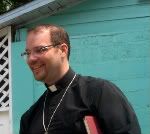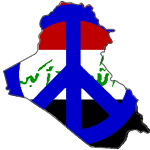a priest's musings on the journey
Thursday, June 07, 2007
Today is my Name Day: St Robert of Newminster
Born at Gargrave, Yorkshire, England, in 1100; died at Newminster in 1159.
Saint Robert, described as "gentle in companionship, merciful in judgment," studied in Paris and wrote a commentary--since lost--on the Psalms.
After being ordained and serving as a parish priest in his native place, he was made rector of Gargrave. He then became a Benedictine at Whitby and joined a band of monks from Saint Mary's Abbey, York, to establish a monastery in which the strict Benedictine Rule would be revived. They settled, in the middle of winter in 1132, in the valley of Skeldale on land given to them by Archbishop Thurston.
The monastery became known at Fountains Abbey due to the presence of springs within its borders. The group became affiliated with the Cistercian reform, and the house became famous for the holiness and austerity of its members and its way of life. Robert was one of its most devout monks. The abbey became one of the centers of the White Monks in north England.
Impressed by the establishment, Ralph de Merly, Lord of Morpeth, built a Cistercian monastery on his own land, the Abbey of Newminster. In 1137 he brought 12 monks from Fountains Abbey and appointed Robert abbot. The monastery flourished under Robert's rule, and he established a house at Pipewell in Northamptonshire in 1143, one at Sawley and another at Roche in the West Riding.
He is said to have had supernatural gifts, and visions and encounters with demons have been attributed to him. He fasted so rigorously during Lent that a brother asked him in concern why he would not eat. He responded that he might eat some buttered oatcake, but once it was placed before him, fearing gluttony, he asked that it be given to the poor. A beautiful stranger at the gate took it--and the dish. While a brother was explaining the loss, the dish suddenly appeared on the table before the abbot. It was thought that the stranger was an angel.
Robert travelled to France again to see Saint Bernard, after he was slandered by some monks about his relations with a pious woman. Saint Bernard appears to have decided that the accusations were false. As a symbol of his belief in Robert's innocence, he gave him a girdle, which was kept at Newminster for performing cures.
Before he returned home, Robert had an interview with Pope Eugenius III, who asked the bishop of Durham to give Robert some land at Wolsingham. Robert frequently visited his close friend the hermit Saint Godric. The night Robert died, Godric is said to have seen his soul ascending to Heaven like a ball of fire.
His relics were translated to the church at Newminster. Miracles were reported at his tomb, including one in which a monk is said to have fallen unhurt from a ladder while whitewashing the dormitory. His tomb became a center of pilgrimage. He is depicted in art holding a church (Attwater, Benedictines, Delaney, Encyclopedia, White).
(I needed a saint praying for me today.)

Robert’s biographer relates how on one occasion Abbot Robert saw the devil in the abbey church at Newminster, in the guise of a bare-legged peasant carrying a basket on his back. The devil appeared outside the choir during the night Office and, rolling his eyes, scrutinised the monks, looking to see which of them was susceptible to temptation. Realising his intentions, Robert prayed earnestly and urged the community to stand firm against temptation. After some time, the devil gave up and went instead to the lay-brothers’ choir and here he struck gold, for he saw a recent recruit, who was already planning his escape from the abbey. The devil, with his three-pronged fork, made off with this man. It was later heard that this former brother of Newminster had been beheaded, as a common thief, a grave warning to any other such recruits that might consider hot-footing it from the abbey.
Saint Robert, described as "gentle in companionship, merciful in judgment," studied in Paris and wrote a commentary--since lost--on the Psalms.
After being ordained and serving as a parish priest in his native place, he was made rector of Gargrave. He then became a Benedictine at Whitby and joined a band of monks from Saint Mary's Abbey, York, to establish a monastery in which the strict Benedictine Rule would be revived. They settled, in the middle of winter in 1132, in the valley of Skeldale on land given to them by Archbishop Thurston.
The monastery became known at Fountains Abbey due to the presence of springs within its borders. The group became affiliated with the Cistercian reform, and the house became famous for the holiness and austerity of its members and its way of life. Robert was one of its most devout monks. The abbey became one of the centers of the White Monks in north England.
Impressed by the establishment, Ralph de Merly, Lord of Morpeth, built a Cistercian monastery on his own land, the Abbey of Newminster. In 1137 he brought 12 monks from Fountains Abbey and appointed Robert abbot. The monastery flourished under Robert's rule, and he established a house at Pipewell in Northamptonshire in 1143, one at Sawley and another at Roche in the West Riding.
He is said to have had supernatural gifts, and visions and encounters with demons have been attributed to him. He fasted so rigorously during Lent that a brother asked him in concern why he would not eat. He responded that he might eat some buttered oatcake, but once it was placed before him, fearing gluttony, he asked that it be given to the poor. A beautiful stranger at the gate took it--and the dish. While a brother was explaining the loss, the dish suddenly appeared on the table before the abbot. It was thought that the stranger was an angel.
Robert travelled to France again to see Saint Bernard, after he was slandered by some monks about his relations with a pious woman. Saint Bernard appears to have decided that the accusations were false. As a symbol of his belief in Robert's innocence, he gave him a girdle, which was kept at Newminster for performing cures.
Before he returned home, Robert had an interview with Pope Eugenius III, who asked the bishop of Durham to give Robert some land at Wolsingham. Robert frequently visited his close friend the hermit Saint Godric. The night Robert died, Godric is said to have seen his soul ascending to Heaven like a ball of fire.
His relics were translated to the church at Newminster. Miracles were reported at his tomb, including one in which a monk is said to have fallen unhurt from a ladder while whitewashing the dormitory. His tomb became a center of pilgrimage. He is depicted in art holding a church (Attwater, Benedictines, Delaney, Encyclopedia, White).
(I needed a saint praying for me today.)

Robert’s biographer relates how on one occasion Abbot Robert saw the devil in the abbey church at Newminster, in the guise of a bare-legged peasant carrying a basket on his back. The devil appeared outside the choir during the night Office and, rolling his eyes, scrutinised the monks, looking to see which of them was susceptible to temptation. Realising his intentions, Robert prayed earnestly and urged the community to stand firm against temptation. After some time, the devil gave up and went instead to the lay-brothers’ choir and here he struck gold, for he saw a recent recruit, who was already planning his escape from the abbey. The devil, with his three-pronged fork, made off with this man. It was later heard that this former brother of Newminster had been beheaded, as a common thief, a grave warning to any other such recruits that might consider hot-footing it from the abbey.
:: posted by Padre Rob+, 2:14 PM
3 Comments:
La Mults Ani Padre!
multumesc, Fr Peter
Blessed name day to you, Padre Rob!And prayers.


